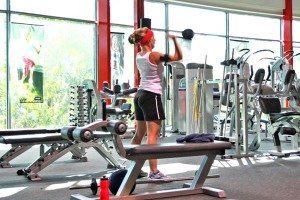To compete in triathlon you need to be the master of three disciplines, yet after all that time spent running, riding and swimming, strength training often takes a back seat. Most triathlon coaches agree that strength training is an essential part of a sound training routine. Done right, strength training improves performance, reduces the risk of injury and slows the gradual loss of strength that naturally occurs after the age of 30.
Despite the well-documented benefits, triathletes understandably have trouble including strength staining in their workouts. With three disciplines already to train for, making time for an additional type of training isn’t realistic for most. But, not integrating strength training into a regimen can leave a triathlete at a major disadvantage.
 In addition to its performance benefits, strength training can play an important role in keeping you healthy and injury-free. Whilst fitting in yet another training activity may sound like an enormous task, you can make yourself a better all-round athlete with a simple strength plan that can take as little as 25 minutes a week. Not only can this make you faster, it’ll also keep you feeling your best as you swim, bike and run to the finish line.
In addition to its performance benefits, strength training can play an important role in keeping you healthy and injury-free. Whilst fitting in yet another training activity may sound like an enormous task, you can make yourself a better all-round athlete with a simple strength plan that can take as little as 25 minutes a week. Not only can this make you faster, it’ll also keep you feeling your best as you swim, bike and run to the finish line.
Strength training results in better performance
Many of the best triathlon coaches in the world will tell you the same thing: Strength training is a vital part of multi-sport training. Strength training is a really important for a triathlete’s performance because there is so much upper body musculature involved in swimming and lower body for running and cycling.
Recent research supports the concept that strength training and improved endurance performance are linked. The Journal of Strength and Conditioning Research reported a 4.6 percent improvement in running economy among those who strength trained along with their regular endurance training. The research also demonstrated a 2.9 percent improvement in 3K/5K performances.
Another study published in the Journal of Applied Physiology looked at both runners and cyclists. After a 10-week resistance-training program, leg strength among participants increased by 30 percent, running time improved by 13 percent, and cyclists were able to ride 14 minutes longer to exhaustion than they could initially.
Strength training to reduce injuries
While performance benefits are perhaps the most tangible, strength training can also help keep you from getting injured. If you took a survey of elite level coaches, they’ll say the most important controllable factor is your ability to train without injury for an extended period of time.
injuries are often caused by muscle imbalances and chronic weaknesses in certain areas. A very basic strength program is the best way to increase the strength of the muscle tissue, as well as the connective tissue, such as tendons and ligaments. As that tissue is strengthened, you will be able to put in more training and remain healthy, which leads to better and faster performances.
Triathlon strength training plan
Strength training is resistance training carried out in the gym using resistance machines or free weights.
 To reap the benefits it is important to train right through the competitive season.
To reap the benefits it is important to train right through the competitive season.
Online magazine, Peak Performance, suggest a 25 minute session once a week with about 14 days off before important performances. Instead of being concerned about sets and reps, set the machines to an approximate weight and do five to 25 repetitions. You will know when you should stop when you have muscle failure, which means that your muscles are so tired you can’t lift the weight another rep. 8 to 15 reps is ideal. If you reach 15 reps and you’re not fatigued, increase the weight the following set.
Peak Performance point out that you should alternate heavy and light weights. They cite the baseball analogy that pitchers who train with light balls and heavy balls end up with a more powerful pitch than those who train with just regular balls. If you want major gains in power you’ve got to combine your weights training with speed training. Running uphill will require leg muscles to produce greater muscular force, but will significantly slow your stride rate. There’s no point being as strong as an ox if you’re snail slow, so you should introduce some light weights and fast reps to the mix, so that the nervous system learns to synergize very rapid muscular contractions.
Next time you head to the gym, consider the following exercises and the muscles they work. In conjunction with a core program, this regimen will help to strengthen all the major muscle groups.
Lower Body Machines:
- Leg press – quadriceps, gluteus maximus, hamstrings, calves
- Seated hip adduction – hip adductors
- Bicep curl – biceps
- Squats – glutes and quadriceps
- Calf raises – calves
- Hamstring curl – hamstrings
- Leg extension – quadriceps
Upper Body Machines:
- Shoulder press – deltoid, trapezius, triceps
- Lateral pull-down – upper back
- Bench press – pectorals
- Shoulder shrug – trapezius
- Back extension – lower back muscles
Building strength training into the training you’re already doing
Who says your strength training has to be seperate from your bike, run and swim training? With a bit of creativity you can build strength work into the training you’re already doing.
Strength training for cycling
When you’re training on the bike in the gym, use indoor intervals to build strength. Rather than pedalling at low intensity to recover from high intensity intervals, jump off the bike and do one leg exercise, one upper body exercise and one core exercise. For example, between a warm up and a cool down, do 5 x 3 minutes at high intensity with a set of squats, a set of push-ups and a set of sit-ups after each interval.
Strength training for running
Try running whilst pulling a tyre to build running strength. Make your ow drag sled to by attaching a six meter rope to a car tyre. Make a harness by twisting an old bike inner tube into a figure of eight and putting your arms through the loops. Tie the other end of the rope to it and you’re ready to go. Run a few sprints of 50 to 100 metres once a week after an easy run.
Strength training for swimming
Try swimming sets in open water with paddles. Paddles are more effective in open water because you don’t have the side of the pool to push against. Alternate 300 metre intervals with and without paddles.
